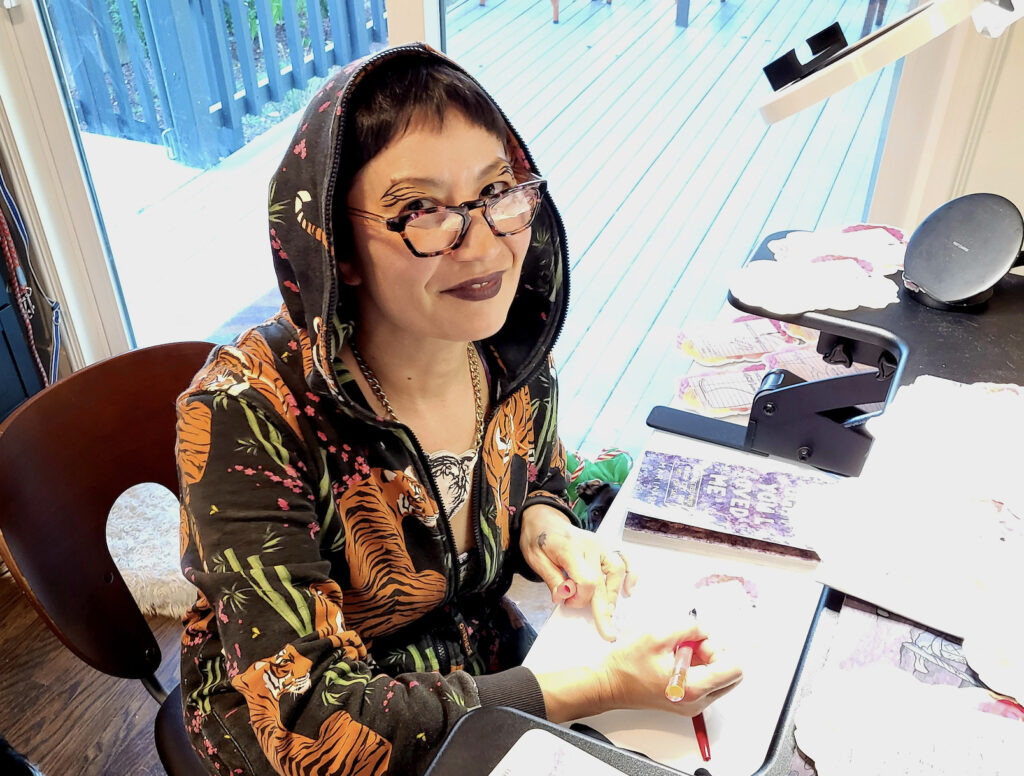Queer banned book author is back with a stunning memoir
MariNaomi’s collage-comics memoir I Thought You Loved Me (Fieldmouse Press, 2023) hits the bookshelves this month.
Jodie was Mari’s best friend through their teens and twenties. As Mari began to explore her identity as a bisexual, biracial outsider in a rich, white town, Jodie was her constant confidant, even kissing Mari out of the closet. The two were inseparable. Suddenly, Jodie ends their friendship. Years later, Mari is stunned when she discovers why. Now much older, Mari is ready to forgive, but her memories of Jodie seem to have vanished. The reader follows in real-time as the author unravels her own mystery, examining the expectations of friendship, the unreliability of memory, and the struggle to let go.
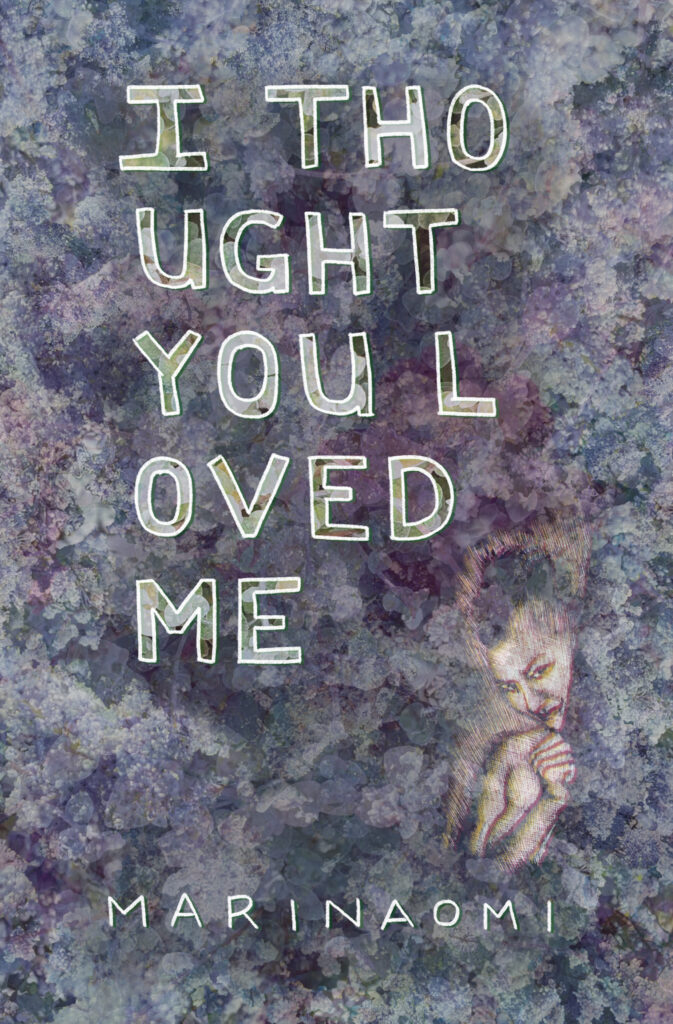
MariNaomi (they/them) is the award-winning banned-book author and illustrator of Kiss & Tell: A Romantic Resume, Ages 0 to 22 (Harper Perennial, 2011), Dragon’s Breath and Other True Stories (2dcloud/Uncivilized Books, 2014), Turning Japanese (2dcloud, 2016), I Thought YOU Hated ME (Retrofit Comics, 2016), the Life on Earth trilogy (Graphic Universe, 2018-2020), Dirty Produce (Workman Publishing, 2021). Their work has appeared in over eighty print publications and has been featured on websites such as The New Yorker’s Daily Shouts, The Washington Post, LA Times, The Rumpus, LA Review of Books, Midnight Breakfast and BuzzFeed. Their comics have been translated into French (Devenir Japonaise, Editions IMHO, 2021) and Russian.
MariNaomi’s comics and paintings have been featured in the Smithsonian, the de Young Museum, the Cartoon Art Museum, the Asian Art Museum, and the Japanese American National Museum.
In 2011 and 2018, Mari toured with the literary roadshow Sister Spit. They are the founder and administrator of the Cartoonists of Color Database, the Queer Cartoonists Database, and the Disabled Cartoonists Database. They have taught classes for the California College of the Arts Comics MFA program, and was a guest editor for PEN Illustrated. They were cohost of the Ask Bi Grlz podcast with author Myriam Gurba.
MariNaomi lives in the San Francisco Bay Area with their partner and a menagerie of beloved rescue animals. We caught up with them to find out more.
Who are you?
MariNaomi: I’m a half-Japanese, half-white pansexual genderfluid Gen-X writer, visual artist, and video game veteran who grew up in the San Francisco Bay Area. I spent a decade in Los Angeles, and recently returned to the SF Bay. I’ve been making comics since 1997 and have published a bunch of memoirs and graphic novels over the years, including the banned young adult graphic novel, Losing the Girl. I’m also the founder and up-keeper of the Cartoonists of Color, Queer Cartoonists, and Disabled Cartoonists databases.
What is your new book about?
MariNaomi: I Thought You Loved Me is a memoir about a long-term friendship that went wrong. My friend ghosted me when we were in our twenties. When I hadn’t gotten over it by the time I was in my forties, I thought it was time to write about it. Focusing on and explaining my experience was an attempt to exorcise my ghost, but then it turned into something else.
Why did you choose to share this with the public versus working it out on your own?
MariNaomi: I have a therapist now, and I joke with her that if I’d started therapy earlier, I would’ve never written this book! But I wonder. I’ve talked about this experience a lot over the years, partly because it’s something that has shaped me, and still continues to do so. And partly because I think it’s an unusual but relatable experience. Lots of people have stories about close relationships mysteriously dissolving, or not getting over old broken friendships. I believe that reading about this could help those people process their own feelings. There’s also a voyeuristic element to it, because the mystery behind our separation turned out to be a lot more scandalous than I had thought they would be.
Also, it’s important that there be more books about friendship out there! This is my second graphic memoir specifically about long-term friendships, and I hope I inspire others to make their own. I want to read them! Friendships are an important part of life that feels under-examined in literature and the media.
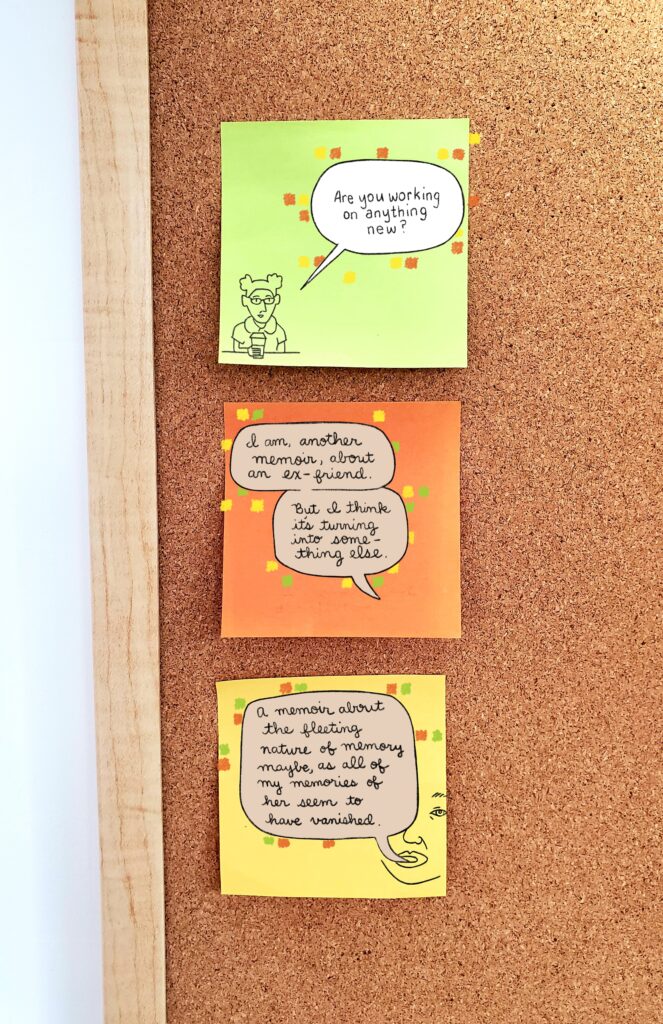
Why did you choose to use collage, prose, and comics?
MariNaomi: I’ve always been drawn to collage and photography. When I started getting comfortable with creating art digitally (not long before I began making this book), collage became a lot more accessible. Like a lot of mid-career cartoonists, I have hand pain that makes analog collage a limited hobby. So now is the time!
In addition, I’m always looking for new ways to tell a story, as I get bored reusing the same methods and mediums again and again. That’s one reason graphic narrative is so appealing to me. There’s always something new to try, so it never gets stale! Of course, when you deviate from the norm, it’s a lot harder to sell a book, but I don’t mind some hardships if it makes it easier for others down the line. That’s my intention, at least.
What was the hardest part about making this book?
MariNaomi: Because it was written as it was happening, for the first time ever, I didn’t know how it was going to end. I started it hoping to sort out my thoughts and bring back some memories, and figure out what really happened amidst so much deception. I wanted closure. As I kept going, although memories did seem to be coming back, it felt like I was opening up old wounds, not putting them to rest. Hundreds of pages in—after YEARS of working on this book—it felt like a story with no ending, but then something unexpected happened that changed everything. The ending was a surprise to even me, and how often does that happen to a writer?
What was the best part about making the book?
MariNaomi: Taking and excavating the photos was really fun, as was laying out the collages and determining my visual metaphors. Making the art and knowing that anything goes was exciting. I got to revel in my nerdy process. I also love how it turned out. It usually takes awhile for me to love my books, but each time I reread it, I feel good about it. It’s a book that I’m proud of. That’s a rare and magical feeling for me.
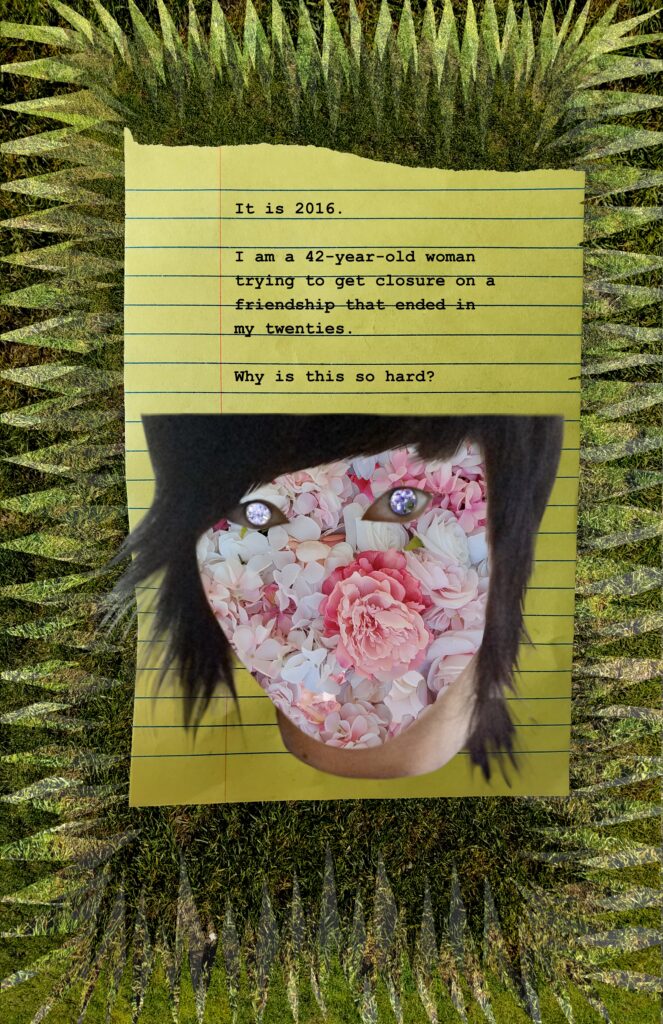
Describe some of the visual metaphors and what they mean.
MariNaomi: The woman who ghosted me is represented visually with loose, squiggly lines and verdant collage. I chose the plant because it felt like her: earthy, mysterious, lovely. The loose squiggles felt like her too–her curly hair, the way she wove in and out of my life and different times, and how I couldn’t get a grasp on who she was when I was making this book. I used rose collage to represent my faith in her. These roses are, at times, artificial, and at others natural, and they are sometimes inside me, sometimes outside me, and sometimes gone. I used a collage of lilacs to represent memory, as the flower’s scent triggers something inside me, a deja vu maybe, and that seemed appropriate. When, in the book, I have a faint memory, you might spot a wisp of translucent lilac. When memories come flooding back in, the lilac comes in strong. I use images like this throughout the book, some with very specific intention, some used more nebulously. I imagine as time goes by, the nebulous parts will solidify for me, and I’ll learn why I made some of the visual decisions I made. That happens with each work, in fact.
I don’t expect readers to fully understand all the visual metaphors, but I hope the images will help intuitively lead them through the emotions of the story.
Tell me about your databases and why you make them.
MariNaomi: I started the Cartoonists of Color and Queer Cartoonists databases in 2014, frustrated by the lack of representation and diversity in the work being published. I mean, I was being published, but it felt like I was discouraged to write about anything that might be unrelatable to straight white cis-folk. It was frustrating. At first the databases were just a list of names and websites I’d gathered on my own. Over time, I enlisted the help of database engineer Cameron Decker, who helped make the databases searchable. A few years later, inspired by the work and experiences of my friends Rus Wooton and Patrick Dean, I started the Disabled Cartoonists database.
I do these for free (actually, they aren’t free to me, but they’re free to everyone else), as a way to bring work and READERS to underrepresented cartoonists, as well as to bring the communities together. I consider it my community service, a way to lift up folks the way I wish I could’ve been lifted up early in my career.
The creation of the databases was a lot of work and stress. Thousands of tedious hours, plus the predictable trolls. These days, though, it’s mostly just pockets of time here and there, as I approve (or not) new profiles, or reach out to folks who submitted their info incorrectly. Not the most glamorous work, but I’ve been told that a lot of creators get work through the databases, that editors, booksellers, librarians, educators, tradeshow organizers and READERS spend a lot of time scouring the databases. So that’s good enough for me.
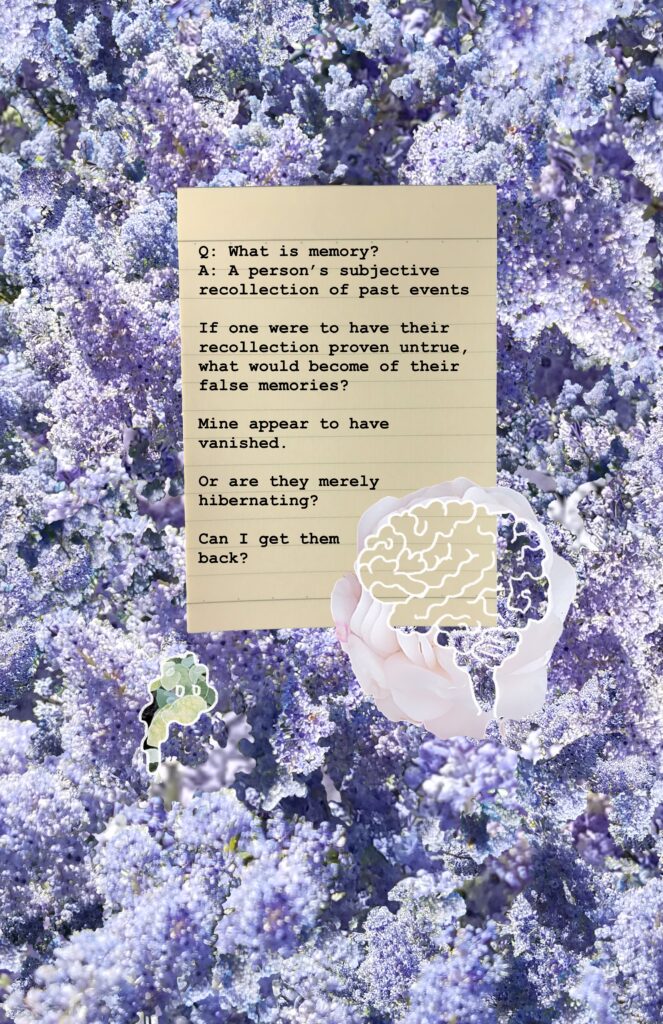
What and who are some of your inspirations?
MariNaomi: I’m inspired by life events that make me laugh or give me trauma–especially when it’s both! I get a lot out of sharing those kinds of stories with others (particularly when those others reciprocate). I enjoy spreading emotion and compassion.
Artistically, I’ve been inspired by so many, but the most notable ones for my career were authors Cheryl Strayed and Armistead Maupin, and cartoonists Mary Fleener, Rob Kirby, and Ariel Bordeaux. These are folks whose work showed me what art and literature could be, which gave me permission to make my own. The best part is, each and every one of them are still making work that continues to inspire me.
For this particular memoir, I was inspired by the collective consciousness of zine-making, The Vicious Red Relic, Love by Anna Joy Springer, the Griffin and Sabine books from the nineties, and House of Leaves by Mark Z. Danielewski. None of these books match the content or style of mine, but the mere fact that they were outside the norm yet managed to exist is encouraging. I love ambitious work that pushes boundaries, regardless of whether it necessarily lands, or if I personally relate to it. Unless we take risks, we’ll forever be stuck in a loop.
What are you doing next?
MariNaomi: Later this year, Oni Press is going to re-release my graphic memoir Turning Japanese as an extended edition. Turning Japanese is about when I was in my twenties, working in hostess bars and trying to get in touch with my Japanese side. It’s been out of print for a number of years, so I’m excited that it’s coming back!
I’m also in the process of writing a middle-grade graphic novel script that the amazing Trung Le Nguyen will illustrate. It’s coming out with Little Brown in 2026 and is about non-binary J-Pop superstars that help a half-Japanese tween come out of her artistic shell.
I also have a completed time-travel graphic novel that my agent is shopping around.
As for future books, I have so many ideas, all of them involving friendships, neighbors, toil, trouble, and all that good stuff. But who knows! Anything traumatic and funny could happen.

